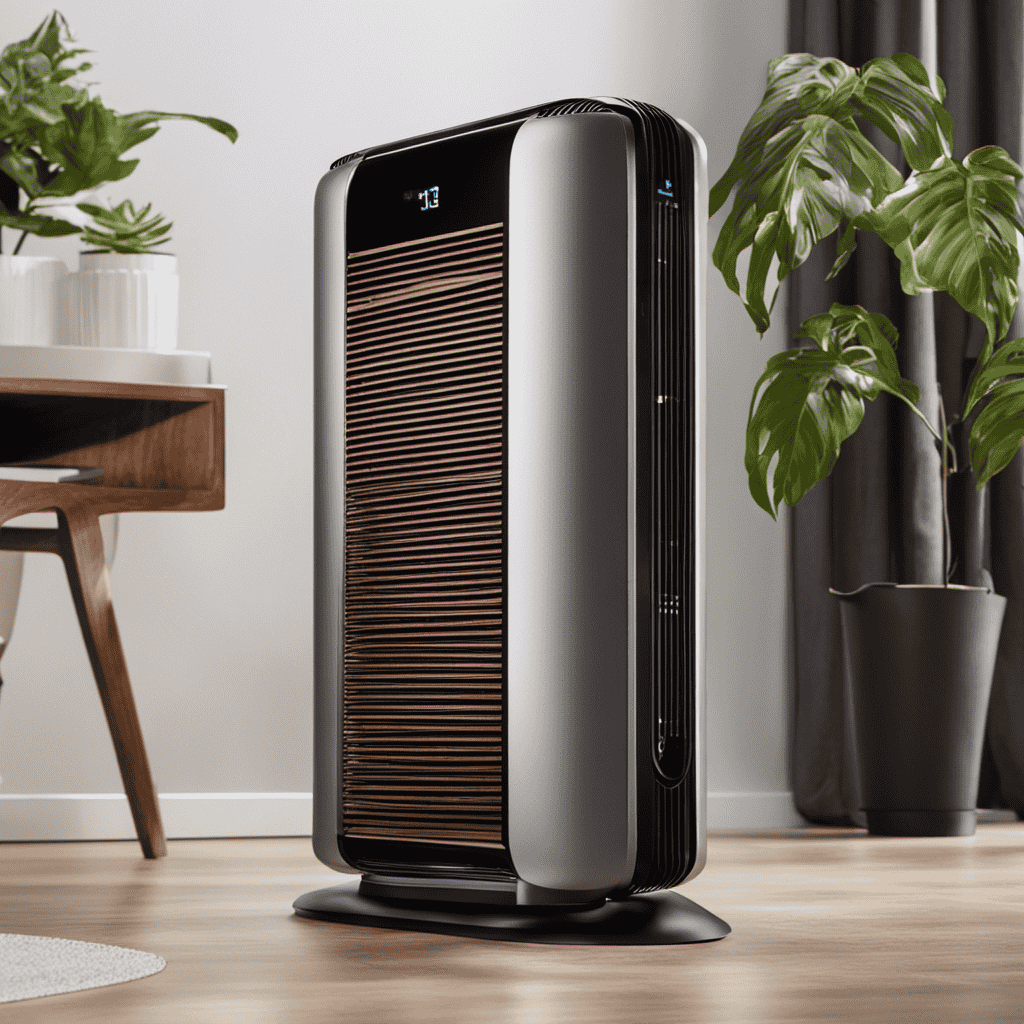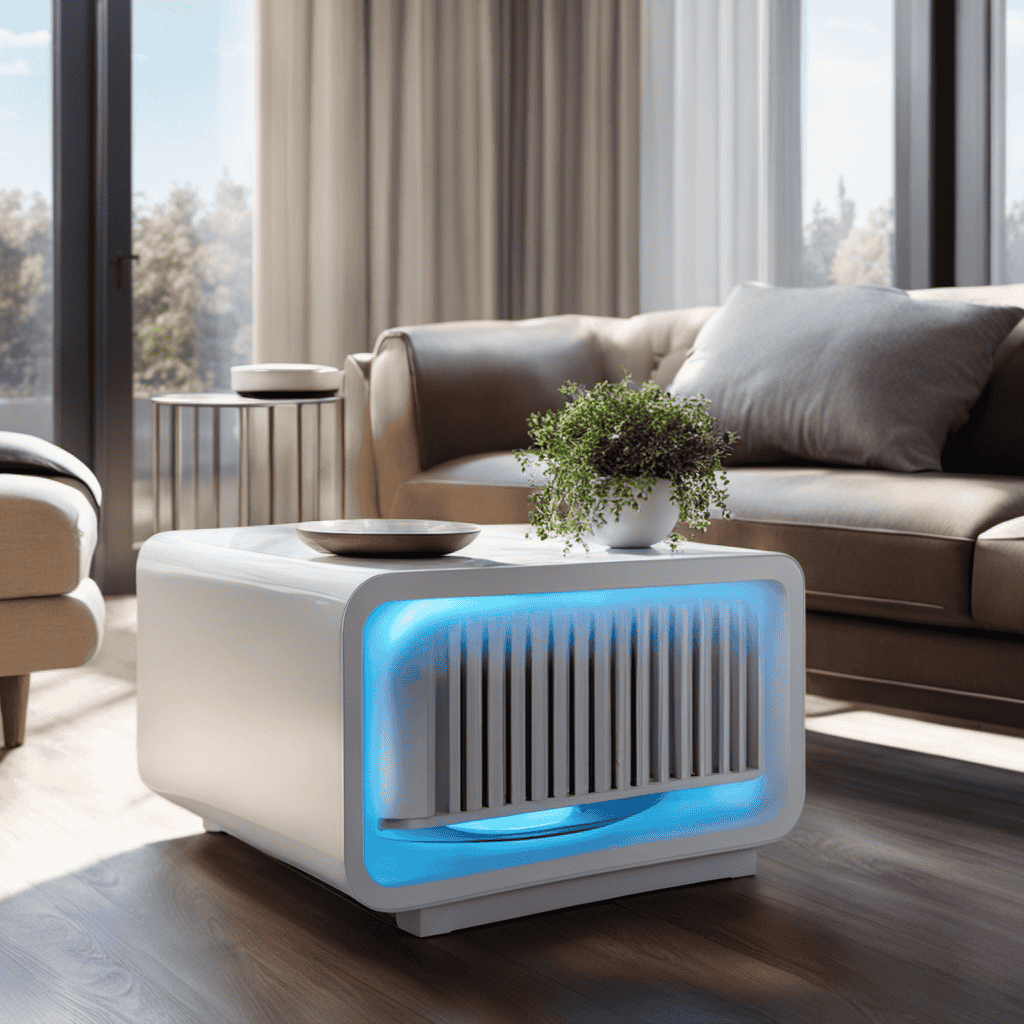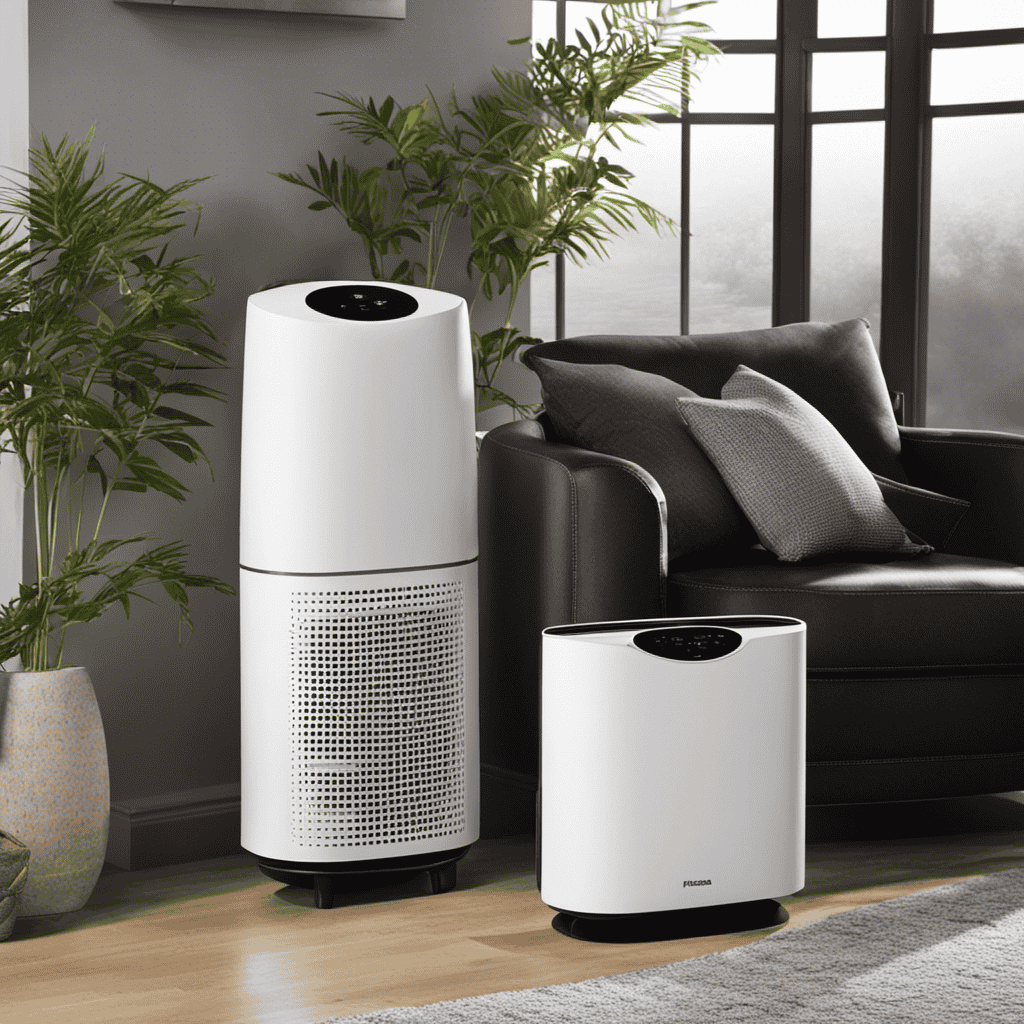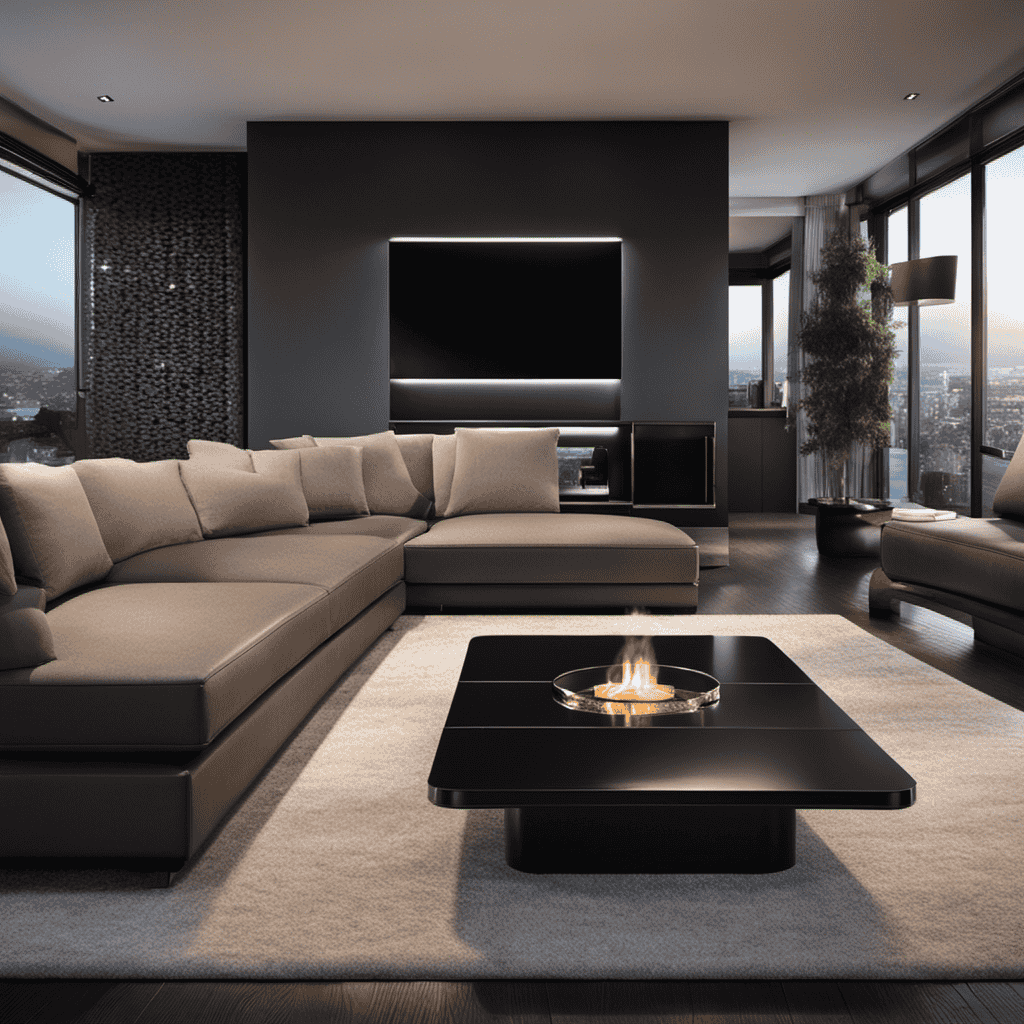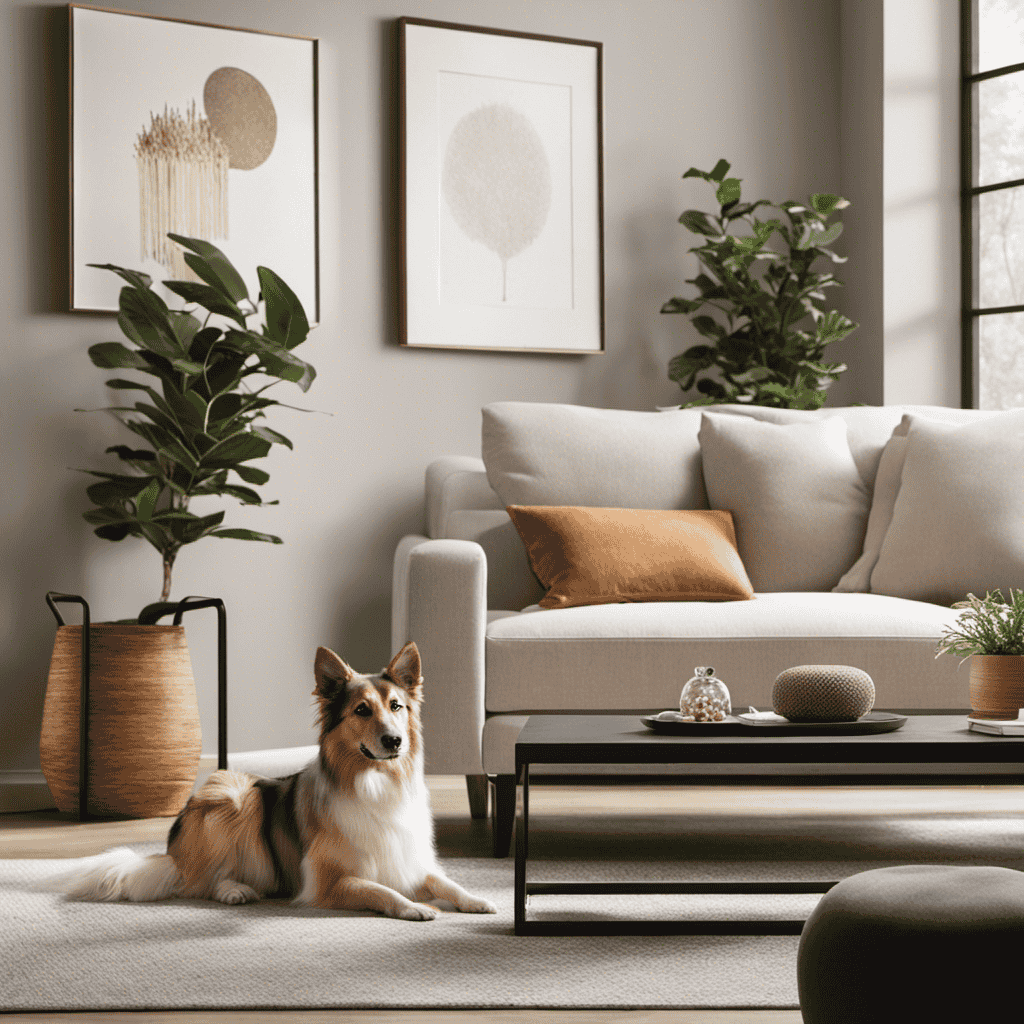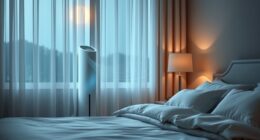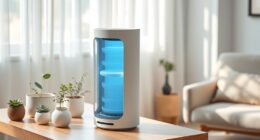I cannot imagine living without my air purifier. It is like having my own superhero that battles unseen villains in the air.
But how does this magical device work its wonders? In this article, we’ll delve into the fascinating world of air purifiers, exploring the different types, the filtration process, and understanding the importance of clean air.
Get ready to discover the secrets behind this incredible invention and how it keeps the air in your home fresh and healthy.
Key Takeaways
- Air purifiers work by using mechanical filters and electronic air cleaners to improve air quality and reduce indoor pollutants.
- The filtration process involves a pre-filter, HEPA filter, and activated carbon filter to trap and remove particles, odors, and chemical pollutants.
- Air purifiers can help reduce indoor air pollutants such as dust, mold, pet dander, and VOCs, which can lead to respiratory issues and allergies.
- Clean air is crucial for respiratory and cardiovascular health, and air purifiers play a significant role in improving overall indoor air quality.
Types of Air Purifiers
There are two main types of air purifiers: the mechanical filter and the electronic air cleaner.
Both types are designed to remove indoor pollutants and improve air quality.
Mechanical filters use a physical barrier to capture particles such as dust, pollen, and pet dander. These filters are made of fibrous materials that trap contaminants as air passes through them.
Electronic air cleaners, on the other hand, use a process called ionization to remove pollutants from the air. They emit negatively charged ions that attach to positively charged particles, causing them to stick to surfaces or be collected in a separate filter.
Both methods are effective at reducing indoor pollutants, but it’s important to choose the right type of air purifier for your specific needs.
Filtration Process of Air Purifiers
To understand how an air purifier functions, you should know that it filters the air through a series of specialized filters. Understanding filtration is crucial in appreciating the benefits of clean air.
The first filter, typically a pre-filter, traps larger particles like dust and pet hair.
Next, the air passes through a HEPA filter, which captures smaller particles such as pollen, mold spores, and bacteria.
Some air purifiers also use activated carbon filters to remove odors and chemical pollutants.
The filtered air is then released back into the room, providing you with cleaner and healthier air to breathe.
By removing these pollutants, air purifiers can significantly improve indoor air quality, reducing the risk of respiratory issues and allergies.
Understanding Air Quality
When it comes to air quality, it’s important to understand the presence of indoor air pollutants and the potential health effects they can have.
Indoor air pollutants can include a variety of substances such as dust, mold, pet dander, and volatile organic compounds (VOCs) that can be emitted from household products and materials.
Breathing in these pollutants can lead to respiratory issues, allergies, and even long-term health problems, making it crucial to address and mitigate indoor air pollution for our well-being.
Indoor Air Pollutants
You can reduce indoor air pollutants by using an air purifier. Indoor air quality is a crucial factor in maintaining a healthy living environment. Common indoor pollutants include dust, pet dander, pollen, mold spores, and volatile organic compounds (VOCs).
An air purifier can effectively remove these pollutants from the air, improving the quality of the indoor environment. Here are two ways an air purifier can help:
-
HEPA filtration: High-Efficiency Particulate Air (HEPA) filters are capable of capturing particles as small as 0.3 microns, removing allergens such as pollen and dust mites.
-
Activated carbon filtration: Air purifiers equipped with activated carbon filters can absorb and eliminate odors and VOCs, providing a fresher and cleaner indoor air.
Health Effects of Pollution
Breathing in polluted air can have adverse effects on our health. The health effects of pollution are significant and wide-ranging.
Particulate matter, such as dust, soot, and smoke, can irritate our respiratory system, leading to coughing, wheezing, and difficulty breathing. Prolonged exposure to air pollutants can also increase the risk of developing respiratory infections, asthma, and other chronic lung diseases. Additionally, pollutants like nitrogen dioxide and ozone can cause inflammation in the airways and worsen existing respiratory conditions.
To minimize the health risks associated with pollution, prevention measures are crucial. These include reducing emissions from industrial sources, using cleaner fuels, and implementing effective air quality regulations. Individuals can also protect themselves by staying indoors during periods of high pollution, using air purifiers, and wearing masks when necessary.
Importance of Clean Air
Clean air is essential for maintaining good health and well-being. Breathing in clean air has numerous benefits and plays a crucial role in our overall health.
Here are some important points to consider about the importance of clean air:
-
Clean Air Benefits:
-
Improved respiratory health: Breathing in clean air reduces the risk of respiratory diseases such as asthma and lung cancer.
-
Enhanced cardiovascular health: Clean air helps prevent cardiovascular problems by reducing the risk of heart attacks and strokes.
-
Air Pollution Control:
-
Regulations and policies: Governments implement measures to control air pollution through regulations and policies.
-
Technology advancements: Advances in technology have led to the development of air purifiers and filtration systems, which help in reducing air pollution indoors.
Air Pollutants and Their Sources
When it comes to air pollutants and their sources, it’s important to be aware of the harmful substances that can contaminate the air we breathe.
Air pollution sources can vary widely, including both natural and human-made factors. Natural sources include forest fires, volcanic eruptions, and dust storms. Human activities contribute significantly to air pollution through emissions from industrial processes, transportation, and the burning of fossil fuels.
These pollutants can have severe health risks, such as respiratory problems, heart disease, and even cancer. Understanding the sources of air pollutants is crucial in implementing effective measures to reduce their impact on our health and the environment.
Transitioning into the subsequent section about ‘hepa filters: the backbone of air purifiers,’ it’s essential to have reliable air purifiers equipped with efficient filtration systems to combat these harmful pollutants.
HEPA Filters: The Backbone of Air Purifiers
Equipped with high-efficiency filters, HEPA filters are essential components of air purifiers, trapping and removing harmful particles from the air we breathe. These filters use a combination of physical and chemical processes to effectively capture pollutants.
Here is how HEPA filter technology works:
-
Physical Filtration:
-
The filter consists of a dense mat of fibers, typically made of fiberglass.
-
As air passes through the filter, particles larger than 0.3 microns get trapped in the fibers.
-
This physical barrier prevents the particles from re-entering the air.
-
Chemical Filtration:
-
HEPA filters often have an activated carbon layer that adsorbs odors and volatile organic compounds (VOCs).
-
The carbon acts like a sponge, attracting and holding these harmful substances.
Activated Carbon Filters and Their Benefits
You’ll be amazed by the benefits of activated carbon filters for improving indoor air quality.
Activated carbon filters are a vital component in air purifiers, especially when it comes to air pollution control. These filters are designed to effectively remove harmful gases, odors, and volatile organic compounds (VOCs) from the air we breathe.
The activated carbon material has a large surface area with countless tiny pores that trap and absorb these pollutants, preventing them from circulating back into the room. This filtration process not only helps to eliminate unpleasant smells but also reduces the risk of respiratory problems caused by exposure to harmful chemicals.
With activated carbon filters, you can breathe easier and enjoy cleaner, fresher air in your home or office.
Now, let’s explore another innovative technology that complements air purifiers: UV-C light technology.
UV-C Light Technology in Air Purifiers
To enhance the effectiveness of your air purifier, consider incorporating UV-C light technology. UV-C light, also known as ultraviolet germicidal irradiation (UVGI), is a powerful tool in eliminating airborne pathogens and allergens.
Here are some benefits of using UV-C light in air purifiers:
-
Kills germs and viruses: UV-C light has the ability to destroy the DNA and RNA of bacteria, viruses, and other microorganisms, preventing them from reproducing and causing harm.
-
Reduces odors: UV-C light can break down volatile organic compounds (VOCs) that contribute to unpleasant odors, leaving your indoor air fresh and clean.
When using UV-C light technology in air purifiers, it is important to take safety precautions:
-
Avoid direct exposure: UV-C light can be harmful to the skin and eyes, so ensure that the light is enclosed within the air purifier and not directly exposed.
-
Follow manufacturer’s instructions: Read and follow the safety guidelines provided by the manufacturer to ensure proper usage and maintenance of the UV-C light technology.
Ionic Air Purifiers and Their Mechanism
When it comes to ionic air purifiers, there are two important aspects to consider: negative ion generation and airborne particle attraction.
Negative ion generation involves the production of negatively charged ions, which are then released into the air. These ions attach themselves to airborne particles, making them heavier and causing them to fall to the ground or be trapped in the air purifier’s filter.
This mechanism helps to effectively remove pollutants and improve the overall air quality in the environment.
Negative Ion Generation
Don’t forget that negative ion generation is a key feature of how an air purifier works. Ion generators, also known as ionizers, are responsible for producing and emitting negative ions into the air. These negative ions attach themselves to airborne particles, such as dust, pollen, and pet dander, making them heavier and causing them to fall out of the air. This process is known as ion emission.
When it comes to negative ion generation, there are a few important things to keep in mind:
- Negative ions are naturally occurring in the environment, but air purifiers enhance their levels for better air quality.
- Ion generators use high-voltage electricity to create negative ions.
- These negative ions attach to positively charged particles, neutralizing them and preventing them from being inhaled.
Understanding how ion generators work is essential in comprehending the overall mechanism of an air purifier.
Now, let’s delve into the next section about airborne particle attraction.
Airborne Particle Attraction
The attraction of airborne particles is a crucial aspect of how an air purifier functions. Airborne particle filtration is the process by which an air purifier removes unwanted particles from the air, such as dust, pollen, and pet dander.
One of the most effective methods of airborne particle filtration is electrostatic attraction. This process involves using an electric charge to attract and capture particles in the air. As the air passes through the purifier, the particles become charged and are then drawn to a collector plate or filter with an opposite charge. This method is highly efficient in removing even the smallest particles from the air.
By incorporating electrostatic attraction, air purifiers can effectively improve indoor air quality and create a healthier environment.
Now, let’s transition into the subsequent section about ozone generators: controversial air purifiers.
Ozone Generators: Controversial Air Purifiers
Ozone generators are often considered controversial air purifiers. While they have their benefits, such as eliminating odors and killing bacteria, there are concerns surrounding their use. Here are some key points to consider:
-
Ozone generator concerns:
-
Ozone production: Ozone generators produce ozone, a gas that can be harmful to humans and pets when inhaled in high concentrations.
-
Health risks: Prolonged exposure to high levels of ozone can irritate the respiratory system, trigger asthma attacks, and cause lung damage.
-
Limited effectiveness: Ozone generators may not effectively remove other pollutants like dust, pollen, or mold spores, which are better addressed by other air purification methods.
-
Ozone generator benefits:
-
Odor elimination: Ozone can neutralize strong odors from smoke, pets, and cooking, providing a fresher indoor environment.
-
Bacteria and virus removal: Ozone has the ability to kill bacteria and viruses, helping to reduce the spread of infections.
Considering the potential risks and limited effectiveness, it is recommended to explore alternative air purification methods that prioritize safety and efficiency.
Air Purifiers for Allergies and Asthma
Using an air purifier can help alleviate symptoms of allergies and asthma. Air purifiers for respiratory health are designed to remove airborne particles, such as dust, pollen, pet dander, and mold spores, from the air.
These particles are known to trigger allergies and asthma symptoms. By filtering the air, air purifiers can reduce the amount of these allergens in the environment, providing relief to individuals with respiratory conditions.
For children with allergies, air purifiers can be especially beneficial. Children are more susceptible to allergens due to their developing immune systems. By using an air purifier in their bedroom or play area, parents can create a cleaner and healthier environment for their children, reducing the frequency and severity of allergy symptoms.
Air Purifiers for Smoke and Odor Removal
Air purifiers can effectively eliminate smoke and odors, making the air cleaner and fresher to breathe. They use various smoke removal techniques and odor elimination methods to achieve this.
Here are some key points to understand:
-
Smoke Removal Techniques:
-
Activated Carbon Filters: These filters are designed to trap and remove smoke particles and odors by adsorbing them onto the carbon surface.
-
HEPA Filters: High-Efficiency Particulate Air (HEPA) filters are effective in capturing smoke particles, including fine particulate matter.
-
Odor Elimination Methods:
-
Ionization: Some air purifiers use ionizers to release negative ions into the air, which attach to odor molecules, causing them to clump together and fall out of the air.
-
Ozone Generation: Ozone generators produce ozone, which reacts with odor molecules and breaks them down, neutralizing the smell.
Understanding these smoke removal techniques and odor elimination methods can help you choose the right air purifier to effectively remove smoke and odors from your indoor environment.
Air Purifiers for Pet Dander and Allergens
When it comes to tackling pet dander and allergens in the air, pet-friendly air purifiers are an essential solution. These specialized air purifiers are designed to effectively eliminate pet dander and other allergens, ensuring a cleaner and healthier indoor environment.
With advanced filtration systems and features like activated carbon filters, HEPA filters, and ionizers, pet-friendly air purifiers provide effective allergen control solutions for pet owners.
Pet-Friendly Air Purifiers
If you have pets, you’ll want to consider pet-friendly air purifiers for a cleaner and fresher home. These purifiers are designed specifically to address the unique needs of pet owners.
Here are some key features of pet-friendly air purifiers:
-
Pet friendly design:
-
These air purifiers are equipped with special filters that can effectively capture and remove pet dander, hair, and odors from the air.
-
The design also includes features like a pre-filter to trap larger particles and a HEPA filter to capture smaller particles, ensuring thorough purification.
-
Pet safe air purification:
-
Pet-friendly air purifiers use advanced technologies, such as UV-C light and activated carbon filters, to neutralize and eliminate harmful bacteria, viruses, and odors that may be present in the air.
-
These purifiers are also designed to operate quietly, ensuring minimal disruption to your pets’ comfort.
Investing in a pet-friendly air purifier will not only provide a healthier environment for you and your pets but also help alleviate allergies and respiratory issues caused by pet dander and other pollutants.
Eliminating Pet Dander
To eliminate pet dander, you’ll want to regularly groom your pets and vacuum your home to prevent the build-up of allergens. Pet dander allergies can cause discomfort and respiratory issues, so it’s essential to take proper measures for pet dander control. Grooming your pets helps remove loose hair and dander from their coat, reducing the amount of allergens in your home. Vacuuming regularly with a HEPA filter vacuum cleaner can effectively remove pet dander from carpets, rugs, and furniture, further minimizing allergen exposure. Additionally, using allergen-proof bedding for your pets and washing their bedding frequently can help reduce pet dander in your home. Taking these steps will significantly improve the air quality in your home and alleviate pet dander allergies.
| Pet Dander Control Tips | ||
|---|---|---|
| Regular grooming | Vacuum with HEPA | Allergen-proof bedding |
| filter vacuum | and frequent washing | |
| cleaner | of pet bedding |
To enhance allergen control solutions in your home, consider using an air purifier.
Allergen Control Solutions
Consider investing in an air purifier to enhance your home’s allergen control solutions. An air purifier is a highly effective tool for reducing indoor pollutants and improving indoor air quality.
Here are a few reasons why an air purifier should be part of your allergen control techniques:
-
Filters: Air purifiers are equipped with filters that capture and remove particles such as dust, pollen, pet dander, and mold spores from the air.
-
HEPA Technology: High-efficiency particulate air (HEPA) filters are designed to capture 99.97% of particles as small as 0.3 microns, ensuring cleaner air in your home.
-
Activated Carbon Filters: Many air purifiers also feature activated carbon filters that absorb and eliminate odors, volatile organic compounds (VOCs), and chemicals.
Investing in an air purifier can help you create a healthier indoor environment by reducing allergens and other pollutants.
Noise Levels and Energy Efficiency of Air Purifiers
The noise levels and energy efficiency of air purifiers can vary depending on the model. When it comes to energy consumption, it is important to consider the wattage of the air purifier. Higher wattage means higher energy consumption, so it is advisable to choose models with lower wattage to save on electricity costs.
As for noise levels, air purifiers are generally designed to operate quietly, but some models may produce more noise than others. It is recommended to check the decibel levels of the air purifier before purchasing. Lower decibel levels indicate quieter operation, which can be beneficial especially during nighttime or in quiet environments.
Overall, considering both energy efficiency and noise levels can help in selecting an air purifier that meets your specific needs.
Maintenance and Cleaning of Air Purifiers
Regularly cleaning and maintaining air purifiers is essential for ensuring optimal performance and extending their lifespan. To help you with the maintenance of your air purifier, here are some maintenance tips and a troubleshooting guide:
Maintenance Tips:
- Clean or replace the filters regularly to remove dust and other particles effectively.
- Wipe the exterior of the air purifier with a damp cloth to remove any dirt or grime.
Troubleshooting Guide:
- If the air purifier is not turning on, check if it is properly plugged in and the power switch is in the ‘on’ position.
- If the air purifier is producing unusual odors, check if the filters need to be cleaned or replaced.
Frequently Asked Questions
Can an Air Purifier Remove Viruses and Bacteria From the Air?
Yes, an air purifier can remove viruses and bacteria from the air. Regular maintenance of the air purifier ensures its effectiveness. Using an air purifier has numerous benefits, such as improving indoor air quality and reducing the risk of respiratory illnesses.
How Often Do I Need to Replace the Filters in an Air Purifier?
I need to replace the filters in my air purifier regularly as part of its maintenance. Signs of a dirty air filter include reduced air flow and a decrease in the purifier’s effectiveness.
Are Air Purifiers Effective in Removing Pet Odors?
Air purifiers effectively remove pet odors by trapping and neutralizing airborne particles. They work similarly to air purifiers for cigarette smoke and mold spores, filtering out contaminants and leaving the air fresh and clean.
Can an Air Purifier Help With Respiratory Conditions Such as Asthma or Allergies?
Yes, an air purifier can help with respiratory conditions like asthma or allergies. It filters out allergens and pollutants, improving air quality. It’s different from a humidifier, which adds moisture to the air.
Are There Any Health Risks Associated With Using an Air Purifier for Long Periods of Time?
Using an air purifier for extended periods may have long-term effects on health and the environment. It’s important to consider potential risks and weigh them against the benefits before making a decision.
Conclusion
In conclusion, air purifiers are an essential tool in maintaining clean and healthy air in our homes. By using various filtration techniques, they effectively remove pollutants and allergens from the air, ensuring a safer environment for us to live in.
But have you ever wondered how much pollution you are breathing in every day? With air purifiers, you can significantly reduce the amount of harmful particles in your home.
So, why not invest in an air purifier and breathe easier today?
